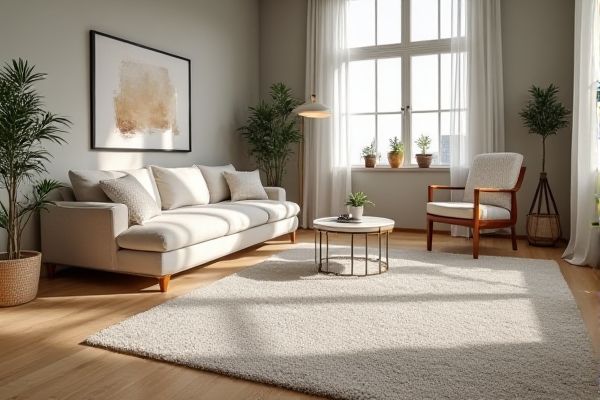
Choosing between a rug and no rug impacts your room's warmth, comfort, and style by either adding texture and color or preserving floor visibility and simplicity. Explore the rest of this article to discover how your choice can transform your living space.
Table of Comparison
| Feature | Rug | No Rug |
|---|---|---|
| Comfort | Soft, warm underfoot | Hard, cold surface |
| Noise Reduction | Absorbs sound, reduces echo | Amplifies noise, echoes more |
| Safety | Reduces slip risk | Higher slip risk |
| Maintenance | Requires cleaning, vacuuming | Easy to clean, sweep |
| Aesthetic | Adds style, color, texture | Minimalist, plain look |
| Cost | Additional purchase and upkeep | No extra cost |
Introduction: The Rug Debate
Choosing between a rug and bare flooring significantly impacts the room's ambiance and functionality. Rugs add warmth, texture, and sound absorption, while no rug offers easier maintenance and showcases flooring materials. Your decision should balance comfort preferences with practical considerations like cleaning and design style.
Aesthetic Appeal: Transforming Spaces
A rug dramatically enhances your room's aesthetic appeal by adding texture, color, and warmth that anchor the space visually. Without a rug, floors can appear bare and cold, leading to a less inviting atmosphere. Choosing the right rug transforms your living area into a cohesive, stylish environment that reflects personal taste and elevates overall design.
Comfort and Softness Underfoot
Rugs enhance comfort and softness underfoot by providing a cushioned surface that absorbs impact and reduces strain, especially on hard flooring like hardwood or tile. Bare floors can feel cold and hard, leading to discomfort during prolonged standing or walking. Choosing a high-quality rug with plush fibers significantly improves warmth and tactile comfort in any living space.
Maintenance and Cleaning Considerations
Choosing a rug can simplify floor cleaning by trapping dust and dirt in a washable surface, reducing direct maintenance on hardwood or tile floors. However, rugs require regular vacuuming and occasional deep cleaning to prevent allergens and stains, while bare floors allow for quick sweeping or mopping but may show dirt and scratches more easily. Your preference for ease of cleaning and maintenance frequency will determine whether a rug or no rug best suits your living space.
Allergy Concerns: Rugs vs Bare Floors
Rugs can trap dust, pet dander, and allergens, making them a potential concern for allergy sufferers if not regularly cleaned. Bare floors such as hardwood, tile, or laminate are easier to keep allergen-free through frequent sweeping and mopping. Choosing hypoallergenic rugs made from natural fibers and maintaining consistent cleaning can minimize allergy issues while still providing aesthetic and comfort benefits.
Noise Reduction Benefits
Rugs significantly enhance noise reduction by absorbing sound waves, lowering overall noise levels in a room compared to bare floors, which tend to reflect and amplify sounds. The dense fibers of rugs minimize echo and footstep noise, creating a quieter and more comfortable environment. Homes with rugs report improved acoustic comfort, especially in multi-story buildings and high-traffic areas.
Cost Analysis: Investment and Longevity
Choosing between a rug and no rug significantly impacts cost analysis, with rugs requiring an upfront investment ranging from $50 to over $1,000 depending on material and size. Rugs enhance longevity of flooring by protecting hardwood or carpet from wear and tear, potentially reducing maintenance and replacement costs. Conversely, opting for no rug eliminates initial purchase expense but may lead to higher long-term costs due to increased floor damage and cleaning frequency.
Safety Factors: Slips and Trips
Rugs provide enhanced traction on slippery floors, significantly reducing the risk of slips and trips in your home. Without a rug, hard surfaces like tile or hardwood can become hazardous, especially when wet or cluttered. Properly secured rugs with non-slip pads improve overall safety by preventing movement that could cause falls.
Versatility and Style Options
Choosing between a rug and no rug significantly impacts versatility and style options in your space. Rugs offer endless design possibilities, from bold patterns to subtle textures, allowing you to easily refresh your room's look and add warmth or color. Without a rug, the room's style depends heavily on flooring materials, which limits opportunities for quick and affordable style changes.
Environmental Impact and Sustainability
Choosing a rug can significantly influence your home's environmental impact and sustainability. Rugs made from natural fibers like wool, jute, or organic cotton are biodegradable and often produced with less energy, reducing your carbon footprint. Opting for durable, ethically sourced rugs supports sustainable practices and minimizes waste over time.
 homyna.com
homyna.com